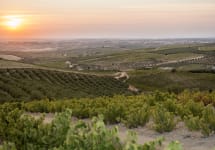Alvear Pedro Ximenez de Anada (375ML half-bottle) 2014
Other Dessert
-
Robert
Parker -
Wine
Enthusiast
4.2 Very Good
(11)
You purchased this 4/16/24



Product Details
Varietal
Producer
Vintage
2014
Size
375ML
ABV
16%
Your Rating
Somm Note
Winemaker Notes
Alvear Pedro Ximénez de Añada is a vintage dated sweet wine from the estate’s Pedro Ximénez vineyards. The grapes are harvested at typical levels of ripeness, and dried in the blazing Montilla sun on mats in the vineyards. The wine is vinified in open clay amphora, and fortified to halt the fermentation.
Professional Ratings
-
Robert Parker's Wine Advocate
The 2014 Pedro Ximenez de Anada is dark amber and sweet, with notes of honeyed figs, maple syrup, toffee and almond liqueur. It is rich and unctuous, very full-bodied and a serious decadent elixir. It should last for 20-30 years, or more.
-
Wine Enthusiast
Alvear is one of Spain's most consistent producers of sweet wines. This vintage Pedro Ximénez is big but fresh on the nose, with apricot and caramel aromas and some heat. A creamy, thick palate is a bit syrupy, while buttered toffee flavors are rich on a highly viscous finish.
Other Vintages
2018-
Wine
Enthusiast
-
James
Suckling -
Jeb
Dunnuck
-
Jeb
Dunnuck -
Wine
Enthusiast
-
Robert
Parker -
Wine
Spectator








Alvear S.A. was established by Don Diego de Alvear in 1729, and since that time has remained under control of the Alvear family. This is the oldest winery in the region and its fino is today one of the three most popular fino wines in Spain. Located in the town of Montilla, in the province of Cordoba, in the interior of Andalucia. Grapes are sourced from their own vineyards, of 307.2 acres. They also buy grapes and wines from local growers. The area is dominated by small parcels. The terrain is formed by undulating hills and slopes of a singular whitish color.
There are two basic types of soil: Albero and Arenas. Albero is a whitish, chalky soil, found on the higher ground in the Sierra de Montilla and Moriles Alto, both of which are classified as superior zones and produce finos of good, clean character. This type of soil is highly absorbent and can supply the vines with needed water during the long, dry summers. The sun bakes the surface to a hard crust, reflecting the heat and preventing the moisture from evaporating. Arenas is found in the Ruedos made up of largely sand, with some stony clay and a small proportion of limestone. The climate is Southern continental, with hot summers, reaching at times temperatures of 120°F, resulting in early harvests. The temperature drops sharply at night, cooling the fermenting musts. Winters are cold.
BOS30180923_2014 Item# 157304
